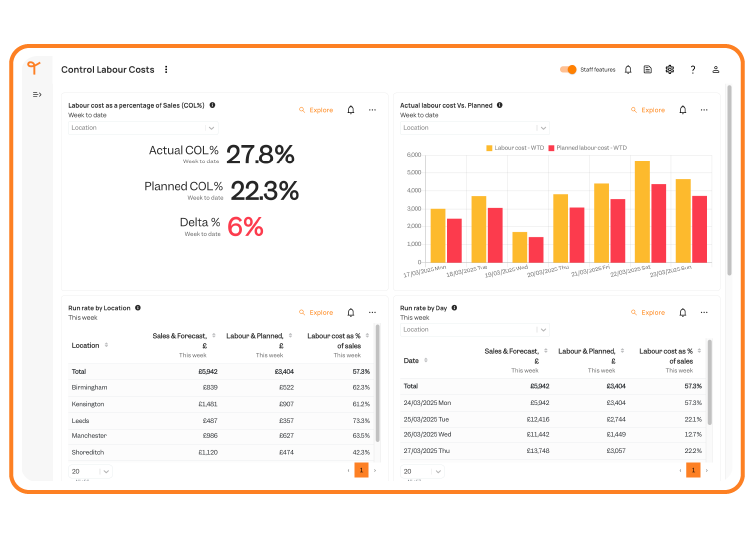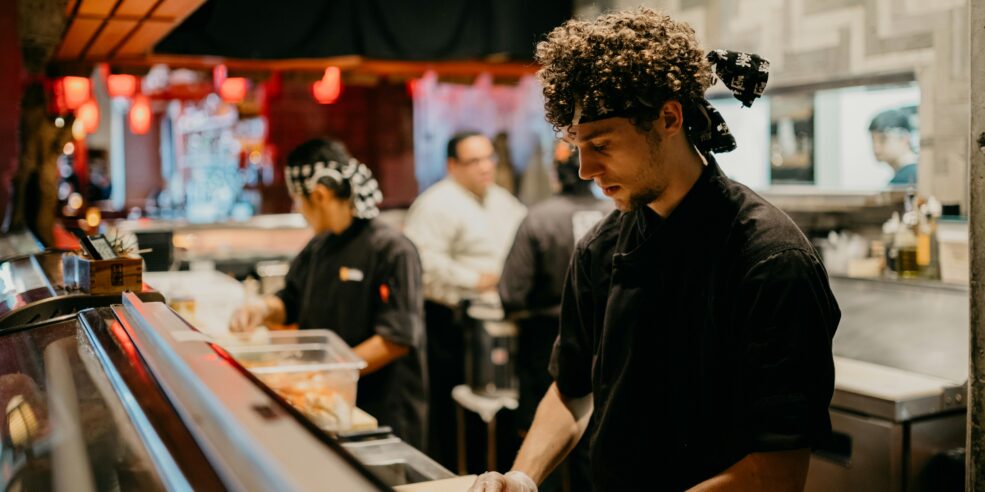In this article
Scheduling your workforce in restaurants or other hospitality businesses is no easy feat. There are so many moving parts, from holidays and leave requests to demand forecasting, that many businesses set a rota and never change or review it just to make life easier.
But labour and staffing costs continue to rise and having a set-it-and-forget-it attitude is no longer financially viable for many businesses. In this article, we’ll give you our top tips for scheduling your workforce in the best possible way for both the business and the team.
1. Use Data-Driven Scheduling to Optimise Labour Costs
Relying on intuition alone to build schedules often leads to over- or under-staffing. Instead, take a data-driven approach to workforce scheduling by analysing sales trends, peak hours, and guest count. This ensures the right number of people are working at the right time.
Tracking sales by labour hour, sales mix vs labour mix, or simply hourly sales and covers can give you the indicators you need to schedule efficiently. The important part is to keep on top of whatever metric you choose to focus on and make weekly changes to the schedule based on the data.

2. Forecast Demand Accurately
One of the easiest ways to improve workforce scheduling is to forecast demand more accurately. Look at past sales patterns, special events, weather trends, and local holidays to anticipate busier or quieter periods. Go beyond a four-week average to predict future sales – special days like Valentine’s or Mother’s Day could skew your entire forecast.
You can do this yourself or use a tool that takes all of your past data into account and uses machine learning to predict future sales (hint: a tool like Tenzo). It’s important that these forecasts are able to flow into your other tools so every team is working off the same predictions whether that’s scheduling in the front of house or ordering in the back.
3. Shift from Labour Targets to Labour Models
Most restaurants stick to a rigid labour target like 30% of sales or £25 per labour hour, but that type of scheduling can keep issues hiding in plain sight.
Here’s why: Picture a slow Tuesday lunch running at 45% labour cost—overstaffed and bleeding margin. Then a slammed dinner hits 20%, leaving your team scrambling. The day averages 30%, but both shifts are off the mark. Static targets miss intraday swings, economies of scale, and the nuance of your operation.
Labour models offer an attractive alternative. Say 0-15 covers/hour needs 1 server + 1 chef; 16-30 calls for 2 servers + 1 chef; 31- 45 ramps to 3 servers + 2 chefs. It’s about aligning staff to demand, not chasing an arbitrary target.
It’s a three-step process to build a labour model:
- Pick Your Inputs: Start with what drives your business – sales, covers, or items (e.g., mains sold).
- Shape the Model: Map staffing to those inputs, and maybe split by front-of-house and back-of-house. This takes trial and error. A small site might need 1 server per 20 covers/hour at peak, while a sprawling layout demands more.
- Refine with Reality: Layer in the messy stuff – opening/closing tasks, training hours, site quirks (e.g., one location’s tight kitchen needs an extra hand). Weigh dine-in vs. delivery (less FOH strain), and account for minimum shift guarantees.
Models beat targets because they adapt. They’re not rigid—life happens—but they cut the guesswork and stress.
Making same-day labour decisions does call for robust reporting and a plan for making sure people aren’t being sent home all the time, but can have a big impact on profitability.
4. Empower Staff with Self-Service Scheduling Tools
Engaging your team in the scheduling process builds trust and flexibility. Self-service tools allow staff to view their rotas, swap shifts, and request time off—all without manager intervention. This can lead to higher satisfaction and better retention and saves the headache of multiple Whatsapp threads and constant negotiation.
Your scheduling tool can also help you schedule well in advance giving your team reliability and the chance to make plans outside of work. Burnout is a big problem in hospitality, but getting your schedules out earlier can give teams a better work-life balance.
5. Benchmark Performance Metrics and Labour KPIs Across Sites
Consistency is key when managing multiple locations. Track key labour metrics such as cost of labour as a percentage of sales and sales per labour hour. These KPIs can help you benchmark your sites and identify top-performing ones.
Check out Tenzo’s guide to tracking team performance and labour performance templates to start measuring the right data.
6. Regularly Review and Adjust Scheduling Practices
Finally, the most effective workforce scheduling strategies are never static. Review what’s working (and what’s not) every week, not just once a month or quarter. Use this time to tweak your approach based on recent data, team feedback, and changing business conditions.
For ideas on improving staff retention and productivity, Tenzo’s insight on labour productivity is worth a read.
Workforce scheduling in restaurants doesn’t have to be a guessing game. With the right data, tools, and mindset, you can build schedules that work for your team and your bottom line. Start small, track what matters, and stay flexible — your business (and staff) will thank you.





